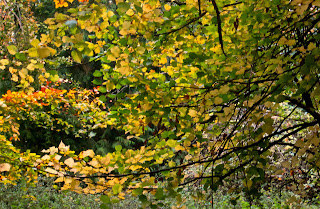 |
| Ragged Copse colour change |
 |
| Mike and some really accurate felling in West Belt |
Anyway back to this week which although dismal weather wise provided a variety of experiences. We started with some wood deliveries to local customers the first of which was in Windrush. I was pleasantly surprised when we delivered the wood that this new customer had a good appreciation of what work was involved in providing the wood, from 'felling through to splitting'. Having completed the deliveries it was back to the nursery to block and split some more wood which was to be stored in the newly formed shelter. In future blocking and splitting is aimed to be done by machine, loaned by Ebworth, which means my axe skills will no longer be required. This means more time will be available for working the woodland and countryside which should be good for wildlife habitats in general. Interesting to note that in our morning travels we encountered the 'local' hunt in full progress, attended by locals in support. Obviously difficult to stop this tradition and one more countryside activity I am not keen on but 'understand' along with the Badger cull which thankfully has been postponed { grateful for its about TB Mark Avery blog}.
The afternoon was spent in the West Belt on continued thinning, part 3 of Wildwood next week, where Mike's experience clearly in evidence especially when felling a sizeable sycamore into a very narrow gap and without destroying my pile of cord wood!
The afternoon was spent in the West Belt on continued thinning, part 3 of Wildwood next week, where Mike's experience clearly in evidence especially when felling a sizeable sycamore into a very narrow gap and without destroying my pile of cord wood!



